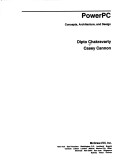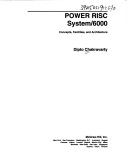J.Ranade Workstation S.
2 total works
The Power PC microprocessor provides a combination of high performance, small size, low power consumption and low price, which makes it suitable for a variety of computer applications - from hand-held computers to multimedia desktop computers to IBM's RS/6000 workstation. This is a comprehensive guide to the design and implementation of the chip that gives RISC-based workstation speed to low-end PCs, enabling them to run Windows, OS/2, Macintosh OS, AIX and other UNIX platforms concurrently. Beginning with an introduction to reduced instruction set computing (RISC), this text describes the electronics of PowerPC, including characteristics derived from its parent POWER architecture, and offers concise descriptions of all implementation procedures. Coverage includes: POWER versus PowerPc architectures, PowerPC processor family (including the 601, 602, 603 and 620 chips), the central electronic complex, cache memory organization, execution units, memory and I/O subsystem, operating environment, PowerOpen, AIX architecture, process management and I/O management.
This work is a reference source for the POWER RS/6000 family of workstations. Starting with a comprehensive overview of hardware and software concepts from a user's perspective, the book then focuses on the facilities available in the operating system and hardware subsystems from a systems point of view. The text is suitable for application and systems programmers implementing AIX on RS/6000. It provides detailed discussions of hardware and software features, including: microchannel features in the RS/6000 platform; fixed and floating point architectures; cache memory organization; superscalar implementation; I/O subsystem organization; AIX operating system kernal structure and processes; data flow issues AIX file system design details; AIX memory and process management features; peripheral device configuration; networking interoperability options; CPU layout; and SCSI interface and related protocols. In addition, the book provides essential maintenance, diagnostic, troubleshooting and administrative procedures for the hardware and software subsystems.

